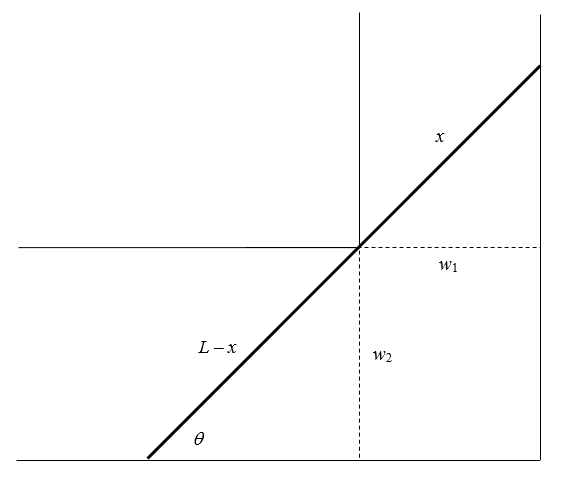Maximum Length of a Ladder Problem
Problem: Find the maximum length, Lmax, of a ladder that can pass through a hall of width of w1 to a hall of width w2 if the ladder is carried exactly parallel to the floor.

Let us consider the length, L, of the ladder as a function of θ, the angle which it makes with respect to one of the walls of the hall as shown in Figure 1. We have the following equalities from the figure:
(1) $\cos\theta = \frac{w_1}{x}$
(2) $\sin\theta = \frac{w_2}{L-x}$
Solving for x in (i) and substitution into (ii) gives:
(i) $L = \frac{w_1}{\cos\theta} + \frac{w_2}{\sin\theta}$
To find maximum of L, we take the derivative of L with respect to θ and set the derivative to 0 to solve the value of θ that will maximize L.
(ii) $\frac{dL}{d\theta} = w_1\frac{\sin\theta}{\cos^2\theta} - w_2\frac{\cos\theta}{\sin^2\theta} = 0$
(iii) $w_1\sin^3\theta - w_2\cos^3\theta = 0$
(iv) $\tan^3\theta = \frac{w_2}{w_1}$
Therefore, the angle that maximizes L is $\theta = \arctan\sqrt[3]{\frac{w_2}{w_1}}$. To find the maximum length of the ladder, we substitute this value into (i).
(v) $L = \frac{w_1}{\cos\left(\arctan\sqrt[3]{\frac{w_2}{w_1}}\right)} + \frac{w_2}{\sin\left(\arctan\sqrt[3]{\frac{w_2}{w_1}}\right)}$
We can use a right triangle with sides of $w_1^{\frac{1}{3}}$ and $w_2^{\frac{1}{3}}$ to find the sine and cosine of this angle.
(vi) $\sin\left(\arctan\sqrt[3]{\frac{w_2}{w_1}}\right) = \frac{w_2^{\frac{1}{3}}}{\left(w_1^{\frac{2}{3}} + w_2^{\frac{2}{3}}\right)^{1/2}$
(vii) $\cos\left(\arctan\sqrt[3]{\frac{w_2}{w_1}}\right) = \frac{w_1^{\frac{1}{3}}}{\left(w_1^{\frac{2}{3}} + w_2^{\frac{2}{3}}\right)^{1/2}$
Substituting (vi) and (vii) into (i), we get:
(viii) $L = \frac{w_1}{\frac{w_1^{\frac{1}{3}}}{\left(w_1^{\frac{2}{3}} + w_2^{\frac{2}{3}}\right)^{1/2}}} + \frac{w_2}{\frac{w_2^{\frac{1}{3}}}{\left(w_1^{\frac{2}{3}} + w_2^{\frac{2}{3}}\right)^{1/2}}$
(ix) $L = \left(w_1^{\frac{2}{3}} + w_2^{\frac{2}{3}}\right)^{1/2}\cdot w_1^{\frac{2}{3}} + \left(w_1^{\frac{2}{3}} + w_2^{\frac{2}{3}}\right)^{1/2}\cdot w_2^{\frac{2}{3}$
(x) $L = \left(w_1^{\frac{2}{3}} + w_2^{\frac{2}{3}}\right)^{1/2}\cdot\left(w_1^{\frac{2}{3}} + w_2^{\frac{2}{3}}\right)$
(x) $L = \left(w_1^{\frac{2}{3}} + w_2^{\frac{2}{3}}\right)^{3/2}$
Therefore, our maximum length of the ladder is $L_{\text{max}} = \left( w_1^{2/3} + w_2^{2/3} \right)^{3/2}$.

 Conic Sections
Conic Sections